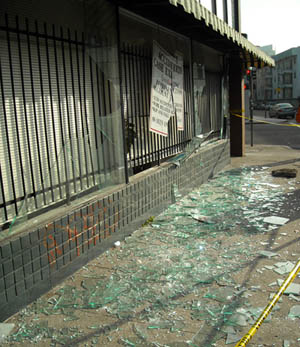in a sprawling city like Los Angeles, crime still clumps together. Mathematical models of burglars presented here today at the annual meeting of the American Association for the Advancement of Science (which publishes ScienceNOW) show that these so-called crime hot spots form when previous crimes attract more criminals to a neighborhood. By understanding how these blobs form, researchers hope to help police departments break them up.

Crime magnet. Shattered glass can attract burglars to a neighborhood.(Photo: Wikimedia Commons / Daniel Ramirez)
Like a scratch on a glass that seeds a crystal, crime tends to clump when roving criminals home in on certain cues in a neighborhood. A broken window from a past burglary, for example, suggests that houses in the area may be easier to break in to, or sprawling graffiti might mean residents aren't very vigilant.
To build a model of how criminals burgle in clumps based on these cues, mathematician Andrea Bertozzi of the University of California, Los Angeles, and colleagues used real crime statistics from the Los Angeles and Long Beach, California, police departments. The model includes roaming burglars who walk around almost randomly but become attracted by specific houses. A house's attractiveness increases if criminals have hit other homes nearby. A halo of increased risk sweeps out from these homes and overlaps with other halos. Soon, the whole area becomes tantalizing to burglars, more criminals swarm in, and hot spots form.
To test the model, Bertozzi used real data on general crime rates from the San Fernando Valley-a region northwest of downtown Los Angeles-and let simulated burglars loose on a map of an 18-square-kilometer area of the valley. The simulated crime clumps overlapped with actual maps from the past year, validating the model.
But can the police break up a hot spot? The answer is complicated because not all hot spots are the same. Some clusters form in isolation, amid a relatively crime-free area, from unusual events, such as a riot caused by the Los Angeles Lakers winning a championship. Meanwhile, everyday crime spikes create so-called supercritical hot spots that grow near other clumps.
When the researchers added police to their models near hot spots, only the isolated clusters disappeared permanently. Supercritical hot spots dispersed and criminals moved elsewhere to create new clumps, suggesting that more police presence around supercritical hot spots will not eradicate the crime spree completely. Bertozzi's team describes its work in a paper that will be published Monday in the Proceedings of the National Academy of Sciences.
As Bertozzi and colleagues develop their models further, they hope to understand how hot-spot growth changes based on a city's range of population densities-from neighborhoods of single-family homes to stretches of apartment complexes. But a big question they'd love to answer is how the police can prevent the clumps in the first place.











